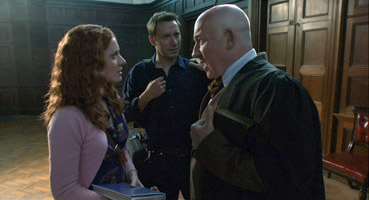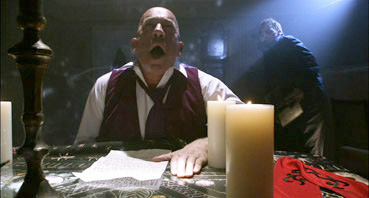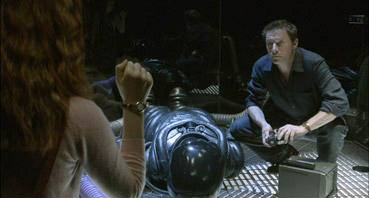|
Heavy metal and Satanism make for cozy bedfellows, or so moral guardians everywhere are fond of telling us. Then again, the bands themselves do tend to court this, revelling in the image of themselves as harbingers of evil and corrupters of youth. It is, of course, a specifically religious form of evil, one that assumes those who embrace it subscribe to a Christian definition of immorality. For the religiously devout, the very concept of devil worship is an unspeakable monstrosity. For the non-religious it's a pantomime that's every bit as silly as the ceremonies it mocks and inverts.
Another popular passtime for the self-styled outsider is to fashion a bond with the bad men of history, particularly those with a psychotic or murderous bent, or those who provoked public or establishment outrage. Enter author, poet, occultist and notorious hedonist Aleister Crowley, a man whose writings and behaviour saw him famously dubbed "the wickedest man in the world," a moniker he doubtless wore as a badge of honour. Now enter Bruce Dickenson, one-time front man for heavy metal gods Iron Maiden, a group who some time ago established their satanic credentials with the 1982 album The Number of the Beast. Well at least we know they saw The Omen. Bruce had wanted for some time to make a film about Crowley, but funding a potentially expensive period piece about a man with his reputation proved a bit of a non-starter. Dickenson thus took an alternative approach that saw the spirit of Crowley transported into the present to take possession of the mind and body of an unsuspecting other.

It all kicks off with a scene-setting prologue in which two students pay a visit to the ageing Crowley, who has the rasping voice and salaciousness of a colossal pervert devised by Derek and Clive. Following his sudden and unexpected death, the film jumps to the present, where Cal Tech science whizz Dr. Joshua Mathers arrives in Cambridge to hook his interactive virtual reality suit up to the university's powerful super-cooled Z93 computer. Little does he know that Victor, the technician assigned to assist him, has been programming the Z93 with everything he can find on Aleister Crowley so that Dr. Haddo, the school's stuttering and slightly daffy Professor of English, can use the suit to absorb all the info in a single supercharged virtual bang. No real surprise that he gets a little bit more than he bargained for. The following day, a shaven-headed and self-confident Haddo arrives at work to deliver a prestigious annual lecture, in which he recites Crowley's "to pee or not to pee" rewrite of Shakespeare's Hamlet soliloquy and then pisses all over his audience. When challenged to answer for his behaviour, he claims that Haddo is now "in the abyss" and that he is the reincarnation of the infamous writer.
It's a setup with few surprises for horror regulars, the favourite satanic components extending to a naked female temptress, orgiastic devil worship and a sacrificial maiden. The born-again Crowley even has an obedient familiar in the shape of the grubbily twitchy Victor, who operates the machinery and deals with the uncooperative. Rounding off the stock components are a good-looking young (American) hero, pretty red-haired reporter Lia for him to save when she gets into trouble, and an ageing sage who, in the Joseph Campbell tradition, provides the information and hardware the hero needs to defeat the villain. To create an appropriately menacing threat for the trio to investigate and do their damnedest to combat, Crowley has been upgraded from wicked writer to the left hand of Satan, a creature capable of laying waste to civilisation, but only through a multi-step ritual process over the course of three days. A bit of luck for humanity, eh?
Overly familiar though many of these elements may be, they are far from disastrous in a genre in which plot recycling and character convention are close to standard practice, with Dickenson and co-writer and director Julian Doyle adding meat to the narrative through the incorporation of chaos theory and dark philosophy. They even throw in a bit of softcore porn and a sometimes adolescent approach to behavioural outrage. Haddo-as-Crowley's dialogue is also literate enough to suggest that the pair either spent some considerable time in the library or have buried themselves in Crowley, Shakespeare and the Bible to the point of obsession.

The odd critical brickbat has been thrown at the performances, but there's some commendable underplaying at work here, at least given the subject matter. Kal Weber and Lucy Cudden make for likeable leads, Paul McDowell offers sturdy assistance as the elderly Symons, and the students are on the whole a surprisingly believable and easy-going bunch. But whether you go with the film or throw your hands to your head in disbelief depends not on these good people, but on the venerable Simon Callow and his no-holds-barred turn as the possessed Haddo. Clearly having a blast from start to finish, he delivers every line with theatrical relish and occasionally plays to a gallery located on the far side of Venus. At it's best this is enormous fun, even if there at times it feels like everyone concerned has taken leave of their senses.
That the plot is implausible is not an issue – it's a science fiction-horror crossover after all – but even within its fantasy framework it sometimes plays more like a collection of intermittently inventive ideas than a singular and cohesive vision. This is reflected in a style and approach that can move in an instant from quietly understated to borderline hysteria, accentuated by André Jacquemin's go-for-it score and ex-Monty Python editor Julian Doyle's breezy direction. And it's hard not to smile at his technical cheek – to introduce Haddo/Cowley proclaiming that "everyone man and woman is a star" with a star wipe takes some balls.
For all its adherence to character convention, its numerous borrowings (The Nutty Professor, Night of the Demon, Damien: Omen II and Donnie Darko are just four) and schoolboy shock value, it's hard not to have a soft spot for a film that wears its absurdities like medals and refuses to admit whether its playing for laughs or just being unintentionally funny. And as far as I'm concerned, Callow's barnstorming performance is worth the admission price alone. Certainly no-one could accuse him of lacking bravery – I can't imagine there are too many name actors who would play a scene in which they were required to furiously masturbate while being violently caned, and do so with such gleefully unrestrained gusto.
Framed 1.85:1 and anamorphically enhanced, this is a close to pristine transfer from a spot-on master, whose contrast colour and detail are all excellent. No obvious signs of banding or other unsightly digital noise either. Good one.

Dolby 2.0 stereo and 5.1 surround tracks are on offer, and there's no contest here. The 5.1 track superior in every respect, the gap widened by how tinny the stereo track sounds by comparison. The surrounds are well used on the 5.1, initially for music but later for specific sound effects, a couple of which are precisely located enough to have you looking over your shoulder. When the action hots up, the entire sound stage, subwoofer included, really comes to life.
Audio commentary
A lively, jovial and informative commentary in which director and co-writer Julian Doyle, co-writer Bruce Dickenson and producer Benjamin Timlett look back at the making of the film, share a few amusing on-set stories, point out the black magic, quantum physics and Masonic texturing, and flesh out the background to the Crowley-inspired detail and quotes that appear in the film. The odd bit of self-congratulation and "I love this..." is nicely balanced by a nice line in mutual piss-taking and groans at the moments where the low budget shows, plus how much they hate the scenes involving cars or generic action. Unwaveringly enthusiastic and great fun, it's a detailed companion to the film – the cheerful tone is set early on when the commentary is interrupted by someone bringing in coffee for the participants.
Revelations: The Making of Chemical Wedding (21:07)
A sprightly collection of behind-the-scenes footage and cast and crew interview material that engagingly explores the genesis of the project and the production itself, but loses a respect points for the tired old suggestion that the production is somehow cursed because of its subject matter. It's actually quite likely this stuff was intended as a misfired gag, given the obvious fakery of a couple of supposedly spookier moments.
Wasted Years: Deleted Scenes (29:18)
A substantial and worthwhile collection of cut scenes and shots, almost all of which are accompanied by a caption from Doyle explaining the reasons for their deletion or offering amused comment on their content. A few are particularly useful in fleshing out minor characters or providing some explanation for the more obscure background detail.
Theatrical Trailer (2:01)
A smartly assembled and persuasive sell that goes some way to suggesting we shouldn't be taking the film too seriously.
The Chemical Wedding Files
A useful collection of textual background information on characters connected with and influenced by Crowley and his writings, including an explanation of the reasons for the character names used in the film.
At times preposterous, jumbled and overblown, but at others understated, focussed and even inspired, Chemical Wedding is some way short of the class act its surprisingly high IMDb score might lead you to expect,* but nowhere near as bad as the critical pasting it has received in some quarters suggests. Either way, for its first rate transfer, the commentary and the deleted scenes, Warner Music's DVD is a good one.
* This rating has since lowersd considerably.
|